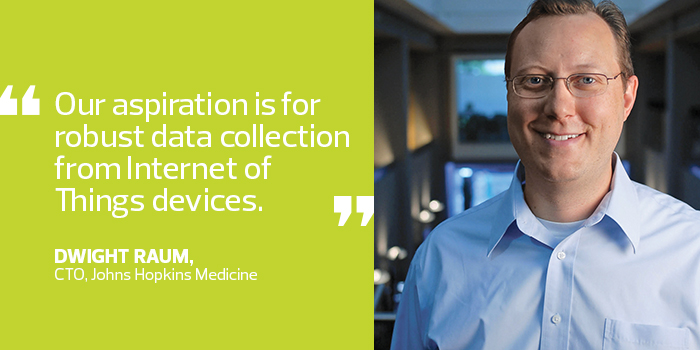Cloud Use Ramps Up for Healthcare Organizations
There’s no surprise diagnosis when it comes to healthcare data. The patient — in this case, healthcare systems and hospitals — is drowning.
And the treatment? For many hospitals and health systems, it’s a massive push into the cloud that will let IT teams better manage that data and help their organizations thrive and drive innovation.
“The only way to enhance innovation and customer service is to move the work that can be moved to the cloud, freeing up full-time employees for new work,” says Dr. John Halamka, CIO of the Boston-based Beth Israel Deaconess Medical Center.
The medical center has taken an aggressive approach to cloud adoption so that it can take full advantage of electronic health records, Halamka says. The move is also fundamental to supporting the medical center’s many affiliated hospitals and practices throughout the Beth Israel Deaconess Care Organization.
BIDCO is an independent accountable-care organization that works with Beth Israel Deaconess Medical Center and other provider organizations to improve quality of care while effectively managing their medical expenses. To benefit from the discounts and potential rewards of membership, participating providers must use a BIDCO-approved EHR system within the first year of membership and must report electronically to participating health insurers regarding performance.
To enable delivery of EHR services to participants, BIDCO built a private cloud with storage-area networks from Dell EMC and server virtualization technology from VMware to support its primary care physician population, which has grown to more than 2,500 members.
Healthcare Has Big Plans for the Cloud
While scalability is a priority for BIDCO, it drives cloud efforts for many other hospitals and healthcare organizations as well.
According to the 2016 Healthcare Information and Management Systems Society’s Analytics Cloud Survey, most healthcare organizations are eyeing strategic use of the cloud. The research found that 59 percent of respondents are using or plan to use cloud computing for Big Data analyses, while more than 75 percent are using or plan to use cloud for healthcare information exchange — a jump from 20 percent of respondents who had similar plans in 2014.
Additionally, 73 percent of respondents say they are using or plan to use cloud to better engage and empower their patients.
“Many small to midsized organizations are turning to the cloud because they can’t afford large IT staffs to manage servers, applications and the rest of the IT environment,” says Kathy Downing, senior director of information governance at the American Health Information Management Association’s IG Advisors group.
Large organizations often turn to cloud providers to enhance business continuity and reliability efforts, Downing says. “If you’re based in an area vulnerable to hurricanes, for example, it’s better to have your backup offsite in another region,” she says.
Security is another factor, she says: Cloud vendors have security and privacy officers who can focus on the latest laws and best practices for safeguarding information.
But not everyone is convinced of the security cloud vendors offer. Audrius Polikaitis, CIO of the University of Illinois Hospital and Health Sciences System, says he will approach his cloud efforts with careful deliberation.
Polikaitis currently uses the cloud for some project management and, eventually, he’d like to use it for his EHR efforts as well.
“Cloud is a wave that’s gaining momentum, even in the sometimes stodgy healthcare industry,” he says. “We’re trying to understand what due diligence we must do to ensure the providers we’d be dealing with have the proper controls in place. For us, EHRs are the big leap.”

Cloud Solutions Solve Problems, Aid Innovation
For caregivers at the Johns Hopkins Health System in Baltimore, cloud adoption has practical applications. A private cloud environment, underpinned by VMware and Microsoft technology, supports a large portfolio of applications used by staff members. In addition to flexibility, speeding the delivery of IT services is one of the biggest cloud payoffs for the organization, Chief Technology Officer Dwight Raum says.
“Cloud allows us to solve the actual problem we’re addressing versus doing all the work to roll out the supporting IT environment,” he says.
Raum also oversees operations for the Johns Hopkins Medicine Technology Innovation Center (TIC), which brings engineers and designers together with faculty members to build and deploy clinical information systems at the organization. Data collection for a number of its efforts — including development of an epilepsy detection application that uses the Apple Watch — resides in the cloud. The TIC teams “turn big ideas, often some really brilliant ones, into reality with technology and software,” Raum says. “Many times, we’re developing solutions that have a cloud architecture from the get-go,” like the epilepsy program.
That’s just one example of a strategic blending of cloud and analytics. Another under development at Johns Hopkins is inHealth, for which TIC plays a key supporting role. inHealth aims to advance individualized and precision medicine.
“Our aspiration is for robust data collection from Internet of Things devices, along with genomic information,” Raum says. “We’re using all this data as the foundation for clinical research going forward, and we plan to make heavy use of cloud-based services for deriving meaningful insights.”
Healthcare Organizations Tap Public and Private Clouds
Beth Israel’s Halamka is a firm believer in the cloud on multiple fronts. The medical center currently uses both private and public cloud technology, he says. Its Microsoft Exchange and inpatient clinical applications run on locally hosted solutions, for which EMC, VMware, IBM and Red Hat systems are used in conjunction with Cisco Systems networking.
Meanwhile, Beth Israel runs an eClinicalWorks EHR system for its nonowned ambulatory practices in a private cloud operated on its behalf. The system uses HP and Dell hardware running VMware. The public cloud is used for a Meditech EHR for the medical center’s community hospitals and an athenahealth EHR for its owned ambulatory sites.
Halamka says his organization will continue to expand the use of public cloud for enhanced scalability and improved service.
And like Johns Hopkins, BIDCO also has some innovative projects pegged to the cloud. For instance, a hybrid cloud soon will host an analytics and population health platform. This custom data warehouse will analyze payer claims for time and resource management, as well as some risk analysis.
“We can show practices where they’re performing well and where there are opportunities for improvement,” BIDCO CIO Bill Gillis says. “Developing actionable data in real time and getting it to the quality managers and physicians in each of the practices will help move the needle to improve patient care while reducing costs.”









